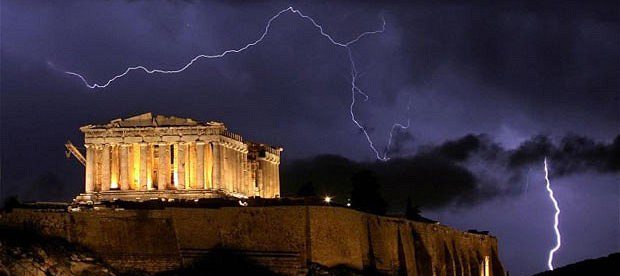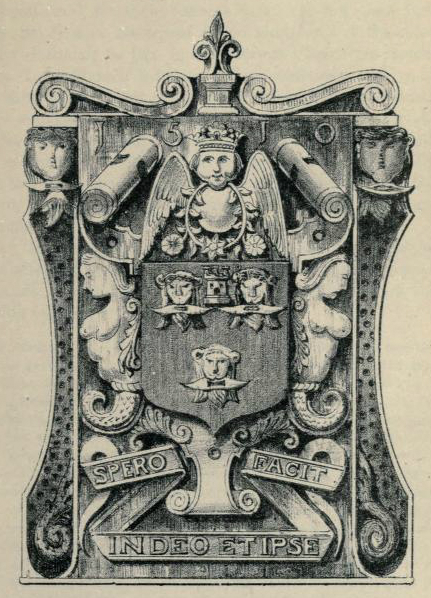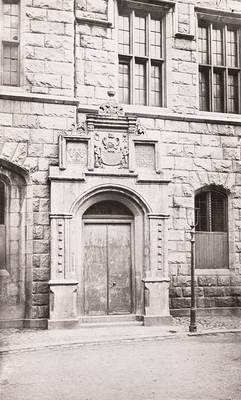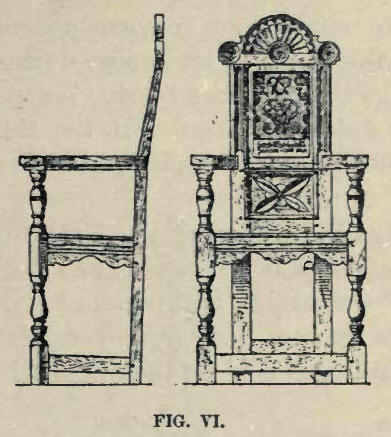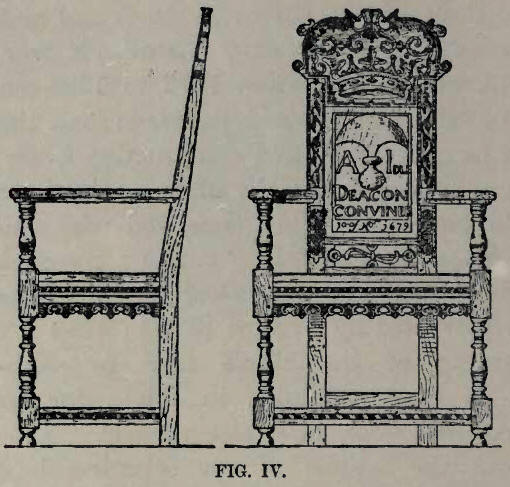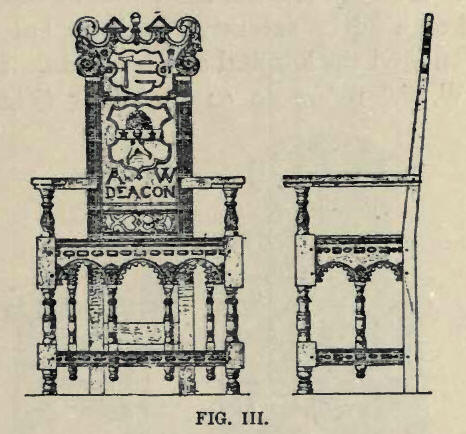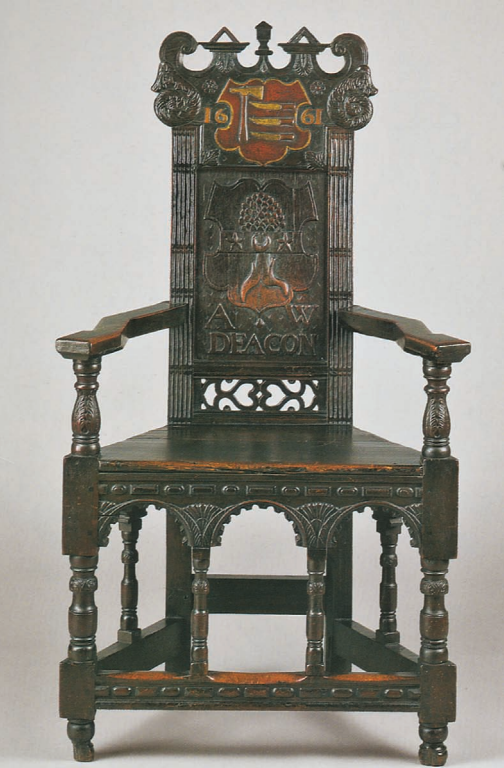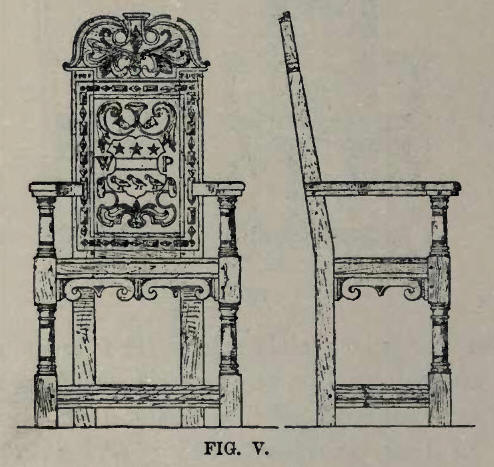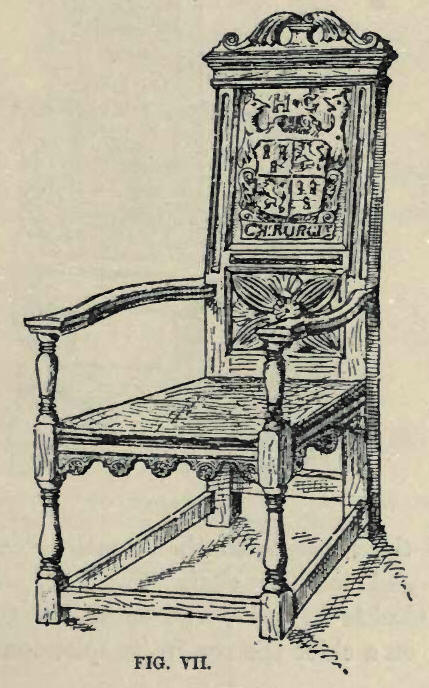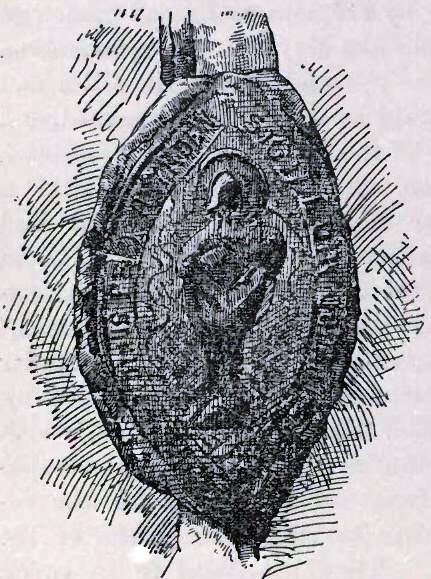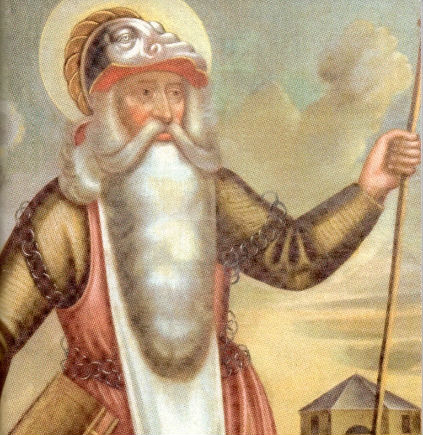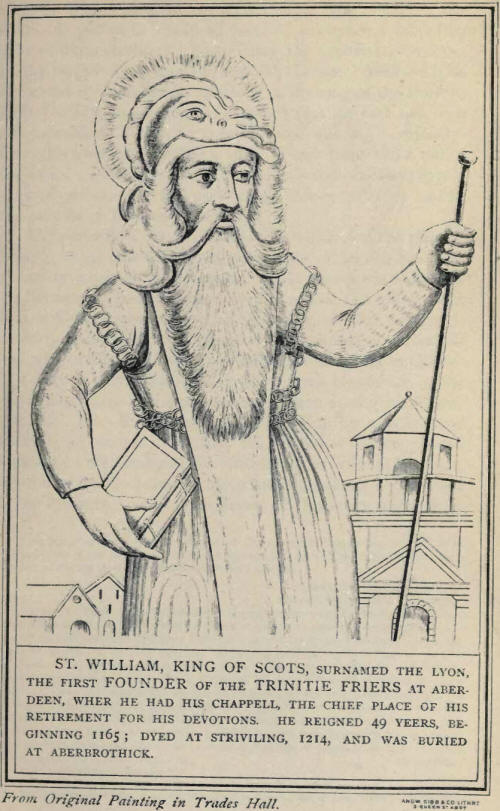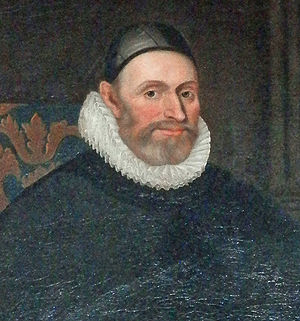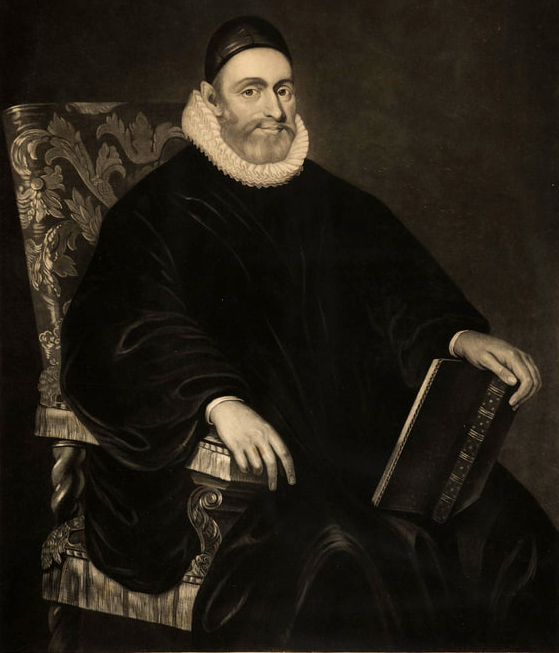The Incorporated Trades Artefacts
Among other Relics transferred from the Old Tarnty Ha’ to the 2nd Trinity Hall were 3-Swords belonging to the Hammermen, Tailors, & Weavers & several remnants of Banners said to have been used at the Pageants in the pre-Reformation days.
The Punch Bowls belonging to the Convener Court, Hammermen, Wrights & Coopers & the Tailors, have also been Preserved. The largest Bowl was presented to the Hammermen by Convener Aleck, who, although a Shoemaker himself, presented the Bowl to the Hammermen because he considered “they were the best Brewers & Drinkers of Punch among the whole of the Craftsmen.” This Bowl is about 2-ft in Dia and stands fully 12-ins high.
The 2-large Bibles that were wont to be used in the Hospital are also in the Master of Hospital’s Press (Cupboard). One of them is a 1578 Bible, but has been allowed to fall into a very tattered condition; the other, dated 1672, is in a better state of Preservation.
The Incorporated Trades of Aberdeen have a Painted Carving in Oak of the Arms of the Weavers dated 1510, azure 3-Leopards’ Heads erased Argent, each holding in its mouth a Shuttle or and in the middle Chief a Triple-Towered the 2nd, a Coat evidently derived from the achievement of the Town itself.
The same Body have also another Painted & Carved Panel with the Arms of Dr Guild, Principal of Marischal College, 1640; & the University of Aberdeen is the Possessor of 2 very fine Armorial Panels – one with the Arms of Bishop Elphinstone, who died in 1514. The Shield is Heater-shaped, so was probably executed not very long after his death; it is surmounted by a Mitre with the Fibulae hanging down on each side; there is a bold Motto Scroll below& just beneath the base point of the Shield are 3-Fishes in Fret, a device taken from the Arms of the University of which he was the Founder. The Body of the Panel, which is about 41-ins x 30-ins, is filled up, not, of course, with Mantling, as there is no Helmet from which it could depend, but with Foliage, which issues from immediately below the Shield, bearing Buds & Flowers, probably intended for Lilies, as they also appear in the Arms of the University. Besides these Arms of its Founder, the University has also a curious Carving of the Royal Arms, formerly in the Royal Mint in Exchequer Row, Aberdeen. It has below it the initials “VR,” fondly supposed at one time to be those of William the Lion. They are probably those of William Rolland, who was Master of the Mint in the Reign of James V.
The Arms themselves are somewhat out of the Common; the Unicorn supporters are reguardant, & the Crest is a Lion couchant guardant holding in its Dexter paw a Sword & in the Sinister a Banner charged with a Saltire.
It can well be believed that the Craftsmen Quitted their Old Hall, so full of interesting Historical Associations, with feelings of Deep Regret. It was a veritable Breaking Away from the Past; and coming as it did about the time that the Special Privileges of the Craftsmen were Abolished, their regret was rendered all the more Sincere. When a Proposal was made to Erect a New Hall, a Veteran Craftsman was heard to declare that before he would Quit the Old Building he would rather subscribe “to have every Stone of it clasped together with Silver” than give a Penny to Build a New Place of Meeting. Another Member, Deacon Alexander Robb, a Local Poet with no mean talent for versification, Sang a Dedication at one of the last Convivial Gatherings Held in the Old Hall.
But whare’s the use o’ waefu’ Skirlin‘,
Lat us a’ be Happy yet,
Altho’ Rail Trains will soon be Dirlin‘
O’er the spot whare now we Sit.
Deacon Robb was not indulging in imaginative Flights when he alluded to Lords & Earls & Lord Chancellors having Honoured the Auld Tarnty Ha’ with their Presence. The Earls Marischal & Huntly & in later times Lord Brougham & Mr Joseph Hume, are mentioned in the Trades’ Records as having partaken of the Hospitality of the Craftsmen.
The different kinds of Essays or Mastersticks which were Prescribed for Entrant Craftsmen to Test their ability to Work were Given. After an Essay has been prescribed, 2–Essay Masters & an Oversman are appointed to Visit the Entrant & see him Working at his Essay & if they have any suspicion that he is being Assisted, they have power to Lock him into a Workshop while he is at Work. An Entrant is now frequently permitted to make some special Article as his Essay, which could be preserved as a Memento of his Entry into his Craft. There are at least 3 of these in the Trades Hall at present, one a unique piece of Weaver Work by James Wilson, Weaver; another, the Arms of the Hammermen Trade, chased in Brass by Mr Robert Rettie; & a 3rd, a beautifully finished & hooped Quarter Cask made by Mr George Gorrod & which is looked after by the Boxmaster of the Wright & Cooper Trade.
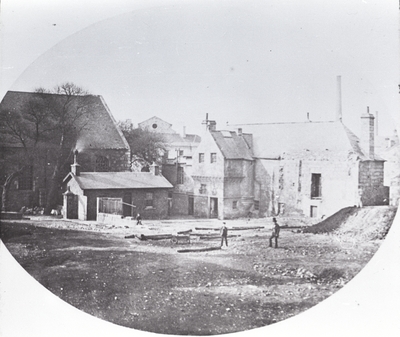
The Trinity Monastery & all its belongings were Bought by Dr William Guild, one of the Town’s Ministers & presented by him in 1633 to the 7-Incorporated Trades. Dr Guild Gifted the Trinity Monastery as a Meeting-House & Hospital to the Trades, he Nominated 6 of the Deacons of the Crafts to Act along with a Patron & Convener in the Management of the Hospital, these 6 being the Deacons who were selected among the Crafts to Vote at the Election of Magistrates. In 1657 the Flesher Trade was Admitted to the Benefits of the Hospital in Terms of an Agreement Sanctioned by Dr Guild; & their Deacon being at the same time admitted a Member of the Convener Court, the number of Trades represented in that Body was increased to its present Number of 7. In addition to the Deacons, the Master of Hospital, the Boxmasters, late-Deacons & 1st Master of each Trade are also Members of the Convener Court. Although recognised from the Outset as a Superior Court by the Craftsmen, the Convener Court has seldom exercised any Jurisdiction over the affairs of the Individual Trades. When Disputes or Difficulties arose, it has acted more as a Consultative than as an Administrative Board. On several Occasions when the Trades considered that the Convener Court had overstepped its Functions, an Appeal was made to the Magistrates or Court of Session, & the Decision was invariably in favour of the Individual Trades having full control of their own Affairs. The last Case of this kind occurred in 1711-12, when the Court of Session Ruled that a Judgment given by the Convener Court regarding one of the Office-bearers of the Baker Incorporation was ultra vires & had to be expunged from the Minutes of the Convener Court. In 1881 a Code of Rules & Regulations was drawn up for the “Guidance of the Members in the discharge of the Duties of the Court,” but no departure of any consequence was made from the established “use & want.”
Trades Hall: This Ornate Trinity Corner Gateway became the Denburn Side Entrance Doorway of New Trinity Hall. The 1st home of the Seven Incorporated Trades of Aberdeen was Located at Trinity Corner the bottom Junction of Putachieside & the old Shiprow (in the area of Market Street/Guild Street.) The Gateway was removed in the 1850s when the New Hall was Erected in Union Street in 1846 & was rebuilt into a Denburn Road Entrance. However, later Reconstruction Work in the 1890’s led to the Demolition of the Gateway although Fragments were Preserved in the Hall. – Ach – jist knocket doon Its Nae Yees Noo!
2nd Trinity Hall, Union Street,
Interior – Main Front Hall & Dining Room 1885
The Main Entrance is from Union Street & on the 1st-Floor are the Hall, measuring 60-ft by 30-ft, with Open Ornamental Roof; 2–Committee Rooms, a Common Room & Retiring Room. From the lower Denburnside, Entrance is obtained to the School Rooms, used as a Trades School down to 1878. In the Upper portion of the Building are the Kitchen & Housekeeper’s Apartments; & immediately above the School is the Strong Room, in which are Stored the Books & Papers belonging to the different Incorporations.
Weavers (pre 1222)
Bakers (1398)
Tailors (1511)
Hammermen (1519)
Shoemakers (1484 & 1520)
Wrights & Coopers (1527)
Fleshers (1534)
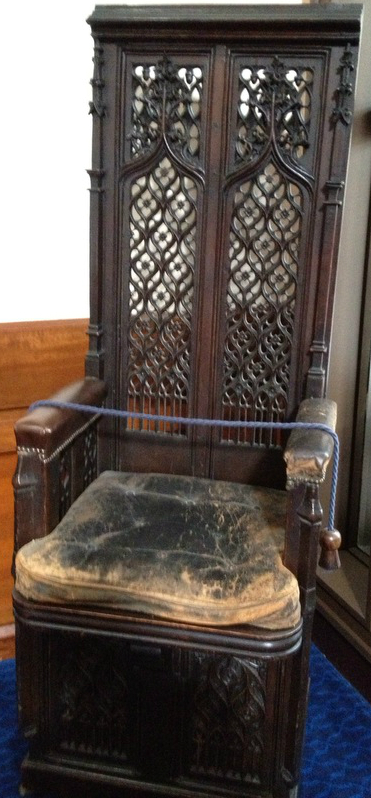
At Trinity Hall, Aberdeen, several of the Chairs presented to the Incorporated Trades bear the Arms of the Donor & his Initials. Among these is the Wrights’ & Coopers’ Chair, dated 1574, bearing the Name & Arms of Jerome Blak. The Barber-Surgeons’ Chair has the Guthrie Arms & the Initials HG. One of the Hammermens’ Chairs bears the Arms of the Mercer Family & LM, for Lawrence Mercer. The Donors’ Arms & Initials also appear on the Chairs of the Fleshers, Coopers & Bakers.
The City was renowned a Century earlier for the Woodwork of John Fendour’s Workshop which
included the outstanding Interior of the City’s King’s College Chapel & The University Library. It is also believed to have to have produced many Caqueteuse Chairs (Gossiping Chairs), including those at the City’s Trinity Hall, throughout the 17thC.
The Chairs: Many Interesting Relics were transferred from the Old Hall to the New Buildings in Union Street.
The Collection of Antique Oak Chairs, presented from time to time for the use of the Deacons of the different Trades, has been long looked upon as the most complete of its kind in Scotland. Some of them date from the time that the Craftsmen Held their Meetings in the Deacons’ Houses, while it is tolerably certain that one of the Largest Chairs belonged to the Old Monastery. This Chair is mentioned in an “Inventory of the Plenishings belonging to the Trinity Hall, taken in presence of Patrick Whyt, Deacon Convener, 1696,” as “King William’s Cheer,” (Chair) & although some of the Framework has evidently been renewed, the Lower Panels (showing Carved Heads of Monks & Warriors) evidently belong to the Early Monkish Period.
The Convener’s Chair, which stands about 6-ft high, has finely-carved Gothic Panels; & some of the other Chairs of smaller size exhibit no small amount of originality of Design & Finish. The Inventory taken in 1696 gives the following List of Chairs, etc, all of which are now in the New Hall & in an excellent state of Preservation.
At Trinity Hall, Aberdeen, several of the Chairs presented to the Incorporated Trades bear the Arms of the Donor & his Initials. Among these is the Wrights’ & Coopers’ Chair, dated 1574, bearing the Name and Arms of Jerome Blak. The Barber-Surgeons’ chair has the Guthrie arms and the initials
HG. One of the Hammermens’ Chairs bears the Arms of the Mercer Family & L M, for Lawrence Mercer. The Donors’ Arms & Initials also appear on the Chairs of the Fleshers, Coopers & Bakers.
Weavers – Ane Public Cheer (Chair) for their Deacon. The Weavers provided a Chair for their Deacon in 1684. It bears the Arms of the Trade, with their Motto, Spero In Deo Et Ipse Facit.
Bakers – Ane cheer, Gifted by John Middleton, Baxter (Baker), Deacon Convener, 1634; ane Cheer, Gifted by Christian Mitchell, son to William Chapman, sometime Deacon of the Baxters, 1668 & another on January, 1704. On one of the Chairs belonging to the Bakers is a portion of the Bakers Arms & also the Middleton Arms, with the Inscription, “My Soul Prais Thou the Lord. I M John Midleton, Deacon, 1634.”
Hammermen – Ane Cheer, Gifted by Lawrence Afersar for the use of said Traid; Ane Cheer, Gifted by Matthew Guild, Armourer; Ane Cheer, Gifted by George Anderson, Goldsmith, Deacon-Convener in 1609; Ane Cheer, Gifted by William Anderson, Goldsmith, Deacon-Convener, 1654; Ane Cheer, Gifted by Alexander Paterson, Armourer, Deacon-Convener, with his pictur, 1685; Ane Cheer, Gifted by Patrick Whyt, Hookmaker, Deacon Convener, with his pictur, 1690; Ane Cheer, Gifted by James Anderson, Glazier, 1692.
Of the 7-Chairs belonging to the Hammermen Trade the Oldest is that supposed to have been Gifted by Laurens Mercer, (Fig-ll) a contemporary of Matthew Guild, Armourer. The Chair bears no Date, but simply the Donor’s Initials “LM,” with the Arms of the Mercer Family (on a Tess, 3-Bezants; a Mullet in Base & 3–Crosses, Potent in Chief) & underneath the Motto – Crux Christi’mea Corona. (Christ’s Cross My Crown) Laurens Mercer was several times Deacon of his Craft from 1572 to 1596 & although others of the same name Joined the Trade sometime after, this Chair, from its appearance & Construction, bears evidence of having been presented by the Mercer who figured so prominently in Matthew Guild‘s time & who also shared the same Punishment as Guild for –
“cumyng throch the Gallowgett on a Sunday with ane Menstrall playand befor Thaim.”
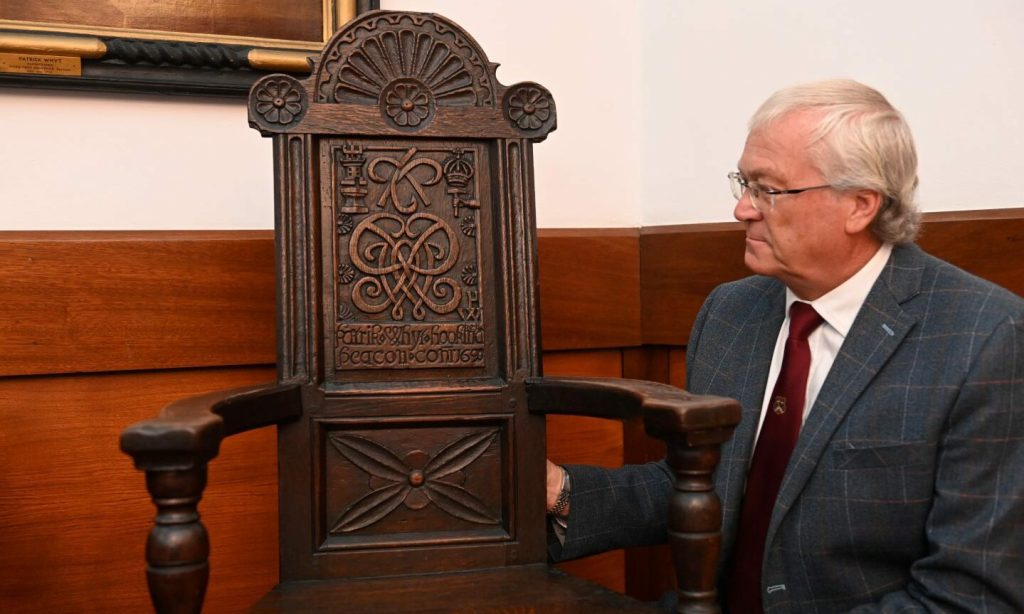
Patrick Whyt, Hookmaker, presented a Portrait of himself, as well as a Chair. (Fig VI) He was several times Deacon of the Hammermen Trade, with which the Hookmakers were Associated & was also Elected Deacon-Convener in 1690. At that time Hook Making seems to have been somewhat extensively carried on having a Large Fishing Community. The numbers of Apprentices appear on Records as having been Indentured to the Calling, which, by the way, included Reed Making & all Work Wire generally. Wire Windows are frequently mentioned as ‘Essays’ prescribed for this Class of Tradesmen during the 16thC.
Whyt’s Chair, besides bearing his name & his designation in full, has a Shield charged with the Hammermen Arms & also 2–Fishing Hooks in Saltire & 1 in Pale with the initials “PW” in Monogram.
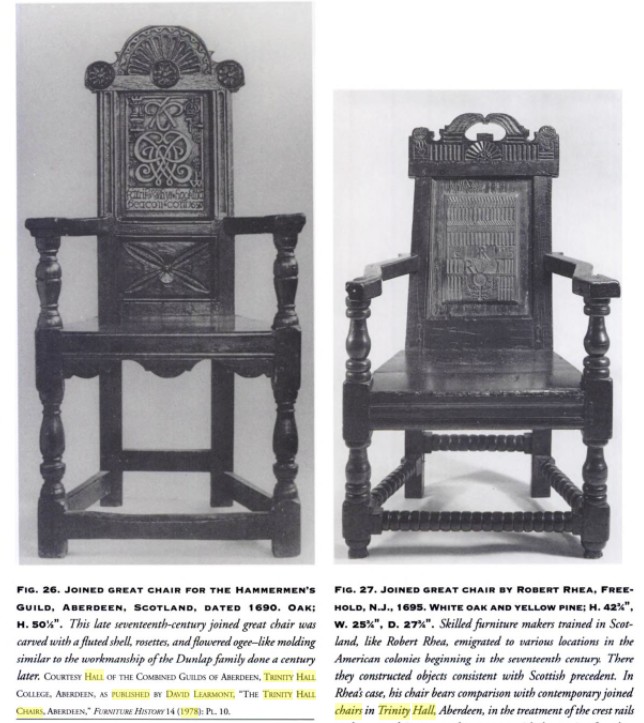
Shoemakers – Ane Cheer, Gifted by Thomas Robertson, Shoemaker, Deacon-Convener, 1633; Ane Cheer, Gifted by Alexander Idle, Shoemaker, Deacon-Convener, 1679; Ane Cheer, Gifted by William Dickson, late-Deacon, 1686. Thomas Robertsone, who presented a Chair to the Shoemakers in 1633 bearing the Inscription “Thomas Robertsone, Deacon-Convener, Grace me God, 1633,” was Killed on the 13th September, 1644, at the Battle of Justice Mills or Craibstane during the Covenanting Troubles. Three other Cordiners were Killed in the same Affray.
Shoemakers Deacon’s Chair: The Chair presented by Alexander Lidle, Shoemaker, in 1679 has the Ducal Crown & Cutting Knife of his Craft carved in the back, with his name, “A Idle, Deacon-Conviner, 30th November, 1679.” Idle had a somewhat chequered Career. The Books of his Trade show that at one time he must have carried on a fairly extensive Business, but during the end of his Days, he entered the Trades Hospital as a Bedeman.
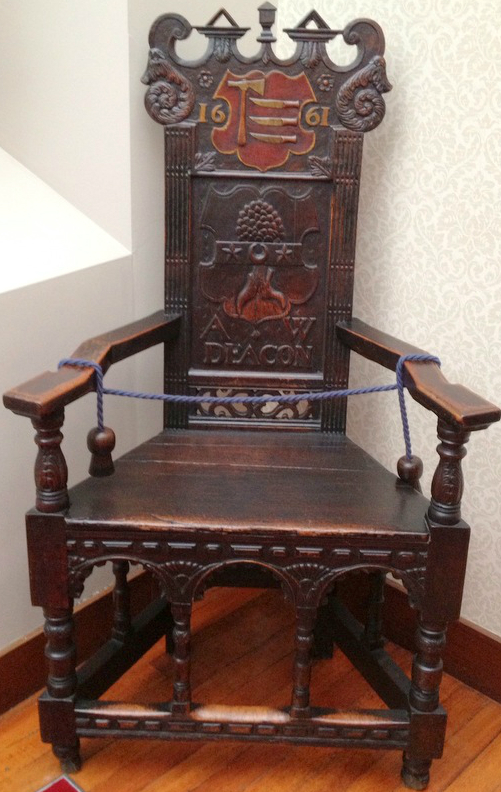
Fleshers – Ane Cheer, Gifted by Andrew Watson, Deacon; ane Cheer, Gifted by John Craighead, Deacon. The Chairs presented about the middle of the 17thC are all of superior Design & better Construction, the Chair Presented by Andrew Watson, Flesher, in 1661 being about the most Elaborate.
The Arms of his Trade are Carved & coloured on the upper part of the back, and on the centre are the Arms of the Watson Family (an Oak Tree Eradicated in Base, surmounted by a Less, charged with Crescent, between 2-Mullets).
Watson was Deacon when the Flesher Trade was Joined to the other 6-Trades under Dr Guild’s Deed of Mortification for the Administration of the Trades Hospital.
A Small Scottish Chair The particularly thick, flat & outwardly curving Arms have a raised rib running along their Outer sides, comparable in Section to those of the Tailor’s Chair, originally dated 1621, at Trinity Hall, Aberdeen.
Hospital Chair: Ane Cheer marked W P Coft (cost) to the Hospital; ane Cheer, Gifted by John Archibald. (Fig V) It is uncertain who the “WP” refers to on the Chair, which, according to the Inventory was bought by the Master of Hospital prior to 1696.
It bears the Paterson Arms (a Fess; in Base, 3-Pelicans Vulnin; 3-Mullets (Stars) in Chief).
Ane cheer, Gifted by Patrick Whyt, Bookmaker, Deacon Convener. At that time Hookmaking seems to have been somewhat extensively carried on, as numbers of Apprentices appear on records as having been Indentured to the calling, which, by the way, included Reedmaking & all working in wire generally. Wire windows are frequently mentioned as Essays prescribed for this Class of Tradesmen during the 16thC. Whyt’s Chair, besides bearing his name & designation in Full, has a Shield Charged with the Hammermen Arms, and also 2-Fishing Hooks in Saltire, and one in Pale with the initials “P W” or ‘W P‘ in Monogram.
Tailors – Ane Cheer, Gifted by Thomson Cordyn, Tayler, Deacon-Convener, 1627;
Ane Cheer or ‘Round‘ Table, Gifted by Alexander Cockie, Tayler (Tailor);
Ane Cheer Gifted by John Forbes, Tayler, 1694.
Tailors: Deacon’s Chair (Fig IX)
A strange looking Chair with a Hinged Dodedecagon 12-sided back which & served a Dual purpose as a Card Table was presented by Alexander Cockie in 1617, who Embellished it with his Family Arms
“a Cock; on a Chief the Sun in its Splendour & a Crescent between 2–Mullets (Stars)” & his Initials “A C“
The Back Folds down upon the Arms & forms a most convenient Regular Dodecagon Card Table with 12 – 150-deg angles that add up to 1800 Degrees
Three Chairs are owned by the Tailor Craft. One bears the Gardine Arms [“a Boar’s Head, erased,”] a Pair of Scissors expanded, the Initials T G & the Words “Thomas Gardine Deacon Convener 1627 In God is my Trust“. Another, Ornamented with Carvings of a Bodkin & a Pair of Scissors, is inscribed “Deacon Geo Gordon, 1690.”
The 3rd has a Shield charged, quarterly,
1, a Goose or Smoothing Iron;
2, a Pair of Scissors expanded;
3, a Pot of Lillies;
4, a Bodkin, in Pale, “inscribed “James Simson, Conviner, 1708.”
The Tailors’ Panel contains no Inscription farther than a List of Craftsmen from 1813. It is the only Shield that Records the Arms to have been Registered; but the Bearings of all the 7-Corporations were duly Matriculated in the Lion Office.
Deacon of the Barber’s Society’s Chair – An Antique Oak Chair, which bears the Inscription- -“H G Chirurgie “with the Guthrie Arms, is said to be Preserved in the Trades Hall & is claimed to have been the Chair used by the Deacon of the Barber’s Society. (Chirurgical is Archaic for Surgical)
(1 & 4, 3 Garbs; 2 & 3, a Lion Rampant) & the Initials “H G” with the word “Chirurgie” underneath, is evidently a relic of the Leechers or Barbers Society, (now Extinct).
The Barbers, who down to the end of the 17thC were designated as Chirurgeons (An Antique Oak Chair, is Preserved in the Trades Hall, & is said to have been the Chair used by the Deacon of the Barber’s Society & Periwig Makers, obtained a Seal of Cause from the Town Council in 1537, Authorising them to Elect a Deacon, make Rules, prescribe an Examination for Entrants, etc, in the same manner as the other Crafts.
In 1674, when they had Established a Benevolent Fund, they obtained a confirmation of their Privileges under the Title of Barbers, Surgeons & Periwig Makers, but ultimately the Association consisted solely of Barbers & Periwig Makers.
On 22nd January 1729, a Petition was presented to the Town Council by “Francis Massie, Barber & Periwig Maker, Present Boxmaster, for himself & in Name of the Haill Incorporation,” for Power to raise the Entry Money from £6 to £12 Scots, on Account of the increased Benefits that were being given from Accumulated Funds. The Prayer of the Petition was Granted, the Incorporation being Ordained to “call the Dean of Guild to their Meetings to Oversee & Inspect their Accounts & to take the Dean’s advice in Stocking & Lending their Money.”
Up to about 1840 there were over 30-Members, but gradually the Membership fell off & several years ago the remanent Members & Beneficiaries entered into a Private Arrangement for Dividing the Stock of the Society among themselves. There was only 1-Surviving Member at the date of Writing (1887).

Wrights & Coopers – Ane cheer, Gifted by Jerome Black, Cooper, 1574;
A Chair Presented by Jerome Black in 1574 is Ornamented with a Carving of the Black Arms (a Saltire, between a Crescent in Base, a Mullet (Star), in Chief; for Crest a hand holding a Cooper’s Adze, in Dexter proper).
Weavers Arms [15th May, 1682]
– Azure, 3-Leopard’s Heads Erased Argent, each having in Mouth a Weaver’s Shuttle or; in the middle Chief a Tower of Aberdeen. Motto: Spero in Deo Et Ipea Facit.
There are also 2-Massive Oak Tables in the Tarnty Ha’. On 10th November, 1699, “the Convener’s Court Ordained Charles Sangster, Master of Traids Hospital, to employ & Pay William Coutts, Deacon Convener, for repairing the Great Table in the Trinities. Lykwise the said William Coutts accepted of the said Employment & promised to project the Work betwixt the Pasch next, under the faiilzie of 10-Dollars & thereupon has subscribed these presents.”
Again, on 18th January, 1703, “the Convener Court Ordains the Master of Hospital to cause mak up the Red Marble Table, and to mak use of the Great Wainscot Table in their Church for that effect.”
Both Tables have Stone Tops about 6-ins in thickness. On the ends of one of the tables are Shields, one being the Guild Family Badge & the other the Initials “DWG.” (Doctor William Guild?) Above are the side & end elevations of the ‘Principal Table’.
There was still to be seen in the 2nd Hall a ponderous Table, at which tradition says the Leonine Monarch (Lion King) was wont to preside. It is a very curious piece of Furniture, consisting of a massive slab of Artificial Stone, smoothly Polished, and set in a beautiful Oak Frame of much later date; the style of the Ornaments showing that it belongs to the early-part of the 17thC. The Framework Bears the Arms of Dr Guild, who Purchased & fitted up the Ruins of the Monastery as a Hospital for Decayed Burgesses of Trade.
The 1st Monarch of whose Residency in Aberdeen there is Authentic Evidence is King William the Lion, grandson of David I. He appears to have Resided frequently, either in the City or County, between the years 1179 & 1214 The oldest Extant Charter of the City was Granted by him & is believed to be the former date. It is still in good preservation. William appears to have had a Palace in Aberdeen, which, about 1211, he Bestowed on the Order of Trinity, Red, or Maturine Friars, whose Chief Business it was to collect Funds for the Redemption of Christians held in Slavery by the Infidels in Palestine. Of this Palace nothing now remains; the Site was occupied by the Old Trades Hall.
Blackfriars Seal: From the Deeds & Papers in the Possession of the Trades pertaining to the Monastery it appears that on 29th September 1381, William de Daulton, Predicant or Black Friar, gave a Donation of 13s-4d Scots to the Trinity Convent to be paid Annually from his House & Land in the Shiprow for the weal of his Soul, the Souls of his father & mother & all the Faithful Departed. This Charter of Donation has appended to it the Seal of the Dominican Friars. The following note descriptive of this Seal (which is in a good state of Preservation) is given by Laing in his well-known Work on Seals:-
A full-length Figure of St John the Baptist, holding in his left hand a Circular Disc, on which is the Agnes Dei, to which the right hand is pointing. In the background are 2-Trees & Foliage. The Inscription appears to be, “Sigillum commune fratrum ordinis predic de Abyrden.” Appended to a Charter by William de Daulton, Brother of the Order, Granting to the Minister & Trinity Friars of Aberdeen an Annual Rent of 13s-4d out of his Lands at the Shiprow, Aberdeen, 30th September 1381.
The Collection of Portraits removed from the Old Hall to the 2nd Trinity Hall Building (in Union Street) has been considerably Augmented of late years, and now forms a highly interesting Collection both as Works of Art and as Memorials of Worthy Citizens well known in their Day & Generation. There are examples by Jamesone, Dyce, RA; Alexander, Archibald Robertson, Joseph Nisbet, G Reid, RSA; William Niddrie, James Cassie, ARSA; J Giles, RSA; J Stirling, J Mitchell & G W Wilson, it will be seen that the Collection is fairly representative of the Works of Local Artists.
Charles Whyt, Painter, anent renewing King William the Lyon, his pictur, as cheap as possible, always not exceeding 50/- Sterling.” Fortunately the “renewing” did not go the length of any interference with the Face. We have it on the Authority of an Artist who took a Drawing of the work in 1821 for Lieutenant-General Hutton that the Face had been left untouched. The King is represented wearing a curiously-formed Helmet & holding a Book in one hand & a Rod in the other. There is a Chain around his waist – indicative, it is said, of penance for the part which History says he had in the Murder of Thomas-a-Becket.
Any discussion of the Scottish Trade Incorporation, Deacon‘s Chair will inevitably begin with the 20-Examples at Trinity Hall. These have been Published previously (David Learmont 1978). The earliest Chair dates from the mid-16thC but the majority, with Carved Inscriptions, commemorating their Donation by the Deacon-Conveners, were made between 1620 & 1690. The Commemorative nature of these Chairs is further evidenced by the appearance of Family Coats of Arms upon 11 of them. This Pattern of Donations was probably unusual, however. Most are also decorated with appropriate Tools (although only 3-Bear the Arms or pseudo-Arms of a Trade) & are of Caqueteuse (Conversation Chair) Form, that is, Tall-backed with an exaggerated Trapezoidal Seat & Arms which curve round to enclose the Sitter. The Caqueteuse Form was the choice in many parts of Eastern Scotland for Ceremonial Chairs before the Advent of the Furniture Pattern Book in the 1740s:
The Depiction of William the Lyon above may have adopted a representation of a Lions Head Helmet. The Helmet represents the Head of the Nemean Lion, whose impenetrable Pelt was worn as a Head-dress and Armour by the Mythological Hero Hercules
“An engraving from a Drawing appears in the “Transactions of the Antiquarian Society of Scotland,” along with the following Letter from Lieutenant-General Hutton to the Secretary of the Society :-
“London, 34 Southampton Row,
“Russell Square, 22nd October 1821.
“Dear Sir, – I request the favour of you to present from me to the Society the Picture of King William the Lyon, which I took the Liberty of sending to your care lately & I shall be much Honoured if it should be deemed worthy of a place in the Society’s Museum. It is a Copy made by an Artist a few years ago from the Original Painting, which is supposed to have belonged to the Monastery of the Trinity Friars of Aberdeen, of which the King was the Founder & is now preserved in Trinity Hall there. It appears from the Records of the Incorporated Trades of Aberdeen that in the year 1715, it having become much Defaced in consequence of its great age, an Agreement was made with Charles White, a Painter, to repair it for a sum not exceeding 50/- Sterling, which was accordingly done, with the exception of the face, which, the Artist who copied the Picture informed me, has been fortunately left untouched. It is Painted in Fresco & its dimensions are about 4-ft in height by about 2ft- 9ins in breadth.
– I remain, yours etc., “H Hutton“. “John Dillon, Esq, Secretary.”
The following Inscription is painted along the base of the picture
“St William King of Scots, Surnamed the Lyon,
The First Founder of the Trinitie Friers at Aberdeeen wher he had his Chappell. The Chief Place of Retirement for his Devotions. He Reigned 49-Years, Beginning 1165, Dyed at Striviling (Stirling) 1214, & was Buried at Aberbrothock (Arbroath).”
The Portrait of Dr William Guild: – which gets the Place of Honour in the New Hall, bears no Artist’s name, but has been generally Ascribed to George Jamesone. Guild was a contemporary of Jamesone’s, is said to have been at School & College with him & was, moreover, a Close Relation [David Anderson of Finzeauch, the Artist’s uncle, was married to Jean, sister to Dr Guild.]; so that nothing is more probable than that Jamesone had Painted a Portrait of one who as Principal of King’s College, a Chaplain to Charles I, a Leading Ecclesiastic & a Generous Benefactor to the Town, must have held a Prominent Position among his Fellow-Citizens. That the Picture was Touched up by a later Hand there is no doubt.
In 1741, the Convener Court Granted Warrant to the Master of Hospital to pay to William Mossman, a Guinea “for his pains and trouble in repairing Dr William Guild’s Picture;” & in the Master of Hospital’s Accounts for the following year there appears “By cash to William Mossman, Painter, for mending Dr Guild’s picture, £12-12s. Scots.” This Sum is equivalent to 21/- Sterling (Guinea). [At the same time the Convener Court expended about £500 Scots in decorating the Hall, the Master of Hospital having been Authorised “to employ Robert Norrie, of Edinburgh, Painter, to Mint & Colour the Trinitie Hall in the Lest & Genteelest manner.” On the 18th May 1731, the Convener Court Granted Warrant “to their Master of Hospital, at the sight of the Deacons, to satisfie and Pay William Mossman, Painter, for Drawing Dr William Guild, their Foundator, his Picture, for which this is Warrand.” This seems to have been an Order for a Drawing taken from the Original, which there are good reasons for believing is the Picture now in the New Hall, and for mending which Mossman was paid a Guinea 10-yrs after. It is hardly probable that his own Drawing could have required “mending” so soon after it was Executed. It is much more likely that, in 1731, Jamesone’s Original had been showing signs of Decay, that Mossman had been ordered to make a Copy of it; and that 10-yrs after he had been Employed to “Mend” the Original itself. The Picture, as it stands, notwithstanding its Renovation, is an excellent one. An admirable Engraving was taken from it some years ago by R M Hodgson, who also ascribes the Original to Jamesone.
With regard to the Portrait of Matthew Guild, father of Dr Guild, there is less doubt of its being a genuine Jamesone. It bears the Inscription, – which Jamesone put upon nearly all his Portraits – the date of the birth & age of the subject; & we have also the familiar Broad Hat which appears in not a few of Jamesone’s male figures.
There also hang in the New Hall several examples by Cosmo John Alexander, a grandson of Jamesone’s, all very fair Specimens of Portraiture. The Portrait of Alexander Webster, Advocate, by Dyce, is justly regarded as one of the finest bits of Portraiture in the Collection & has on more than one occasion been exhibited in Collections of old Scottish Masters in the South. Alexander Webster had no direct connection with the Trades, but he took a warm interest in the Trades School, which was instituted in 1808, about the time his father held the Office of Deacon-Convener.
Cosmo John Alexander, son of an Aberdeen Doctor, was the great-grandson of George Jamesone, the most famous Scottish Painter of the 17thC. After some time in London, Alexander travelled to Italy in 1711 where he studied under Giuseppe Chiari & received Commissions from the Stuart Court in Exile. When he returned to Scotland in 1720 he worked for the Duke of Gordon, a Catholic & a staunch Jacobite & produced his most ambitious work, a Ceiling Painting for Gordon Castle. Most of his Clients were from the North-east of Scotland & many were Jacobites. He took up Arms for Prince Charles in the 1745 Rising & became a Fugitive after Culloden but was back in Edinburgh working Openly by 1748.
The above Picture is of Historical interest as the old Trinity Church at Trinity Street (once the Alahambra Music Hall) has been Incorporated into a string of Shops with a Pub encroaching on the Pavement area. This Development may have been necessary due to the arrival of the Aberdeen – Caledonian Railway Terminus. The Waverly Hotel stands opposite the Old Caledonian Railway Station Building. The Fountain was Located on the edge of the Quay & the Horse & Cart stand at rest on the Diagonal Wooden Corner Deck of the Upper Dock on Trinity Quay which was added to Accommodate the Lines curve of the Harbour’s Steam Railway Line used mainly for the movement of Coal. Andrew Fidler was a locally based Coal Merchant who also used Horses to conduct his Distribution Trade. The Horse with the single-Axle Cart is slaking its thirst from the convenient Fidlers Well/Fountain Trough which was now been further relocated 2nd in Guild Street & then 3rd to outside the New Trinity Hall in Holburn Street.
It was also used as a fine wee Boating Pond for this Local Bairn to Sail handcrafted Wood & Paper Boats in its Depths when its 2nd Relocation Site was in the South Gutter of Guild Street outside the Goods Station Wall – during the 1940s. It’s a shame ye canna have wee sail o’ yer boat ‘doon the slurpin’ watters’ these days.

Tall original Antique Cast Iron Well Pump. Painted black, with side Door for access to the Pump Handle – may be a Relic from the original Tarnty Ha’. Appears to be fitted with a Hinged Door & Lock to prevent misuse of the Reserves by Interlopers.
Our auld Forebears o’ Deathless Fame,
As Chronicles record,
At Bon-Accord’s all sacred name,
Fu’ aften drew the Sword.
‘Tis ken’d the Craftsmen a’ Set out,
An’ fought a fam’d Harlaw,
An’ did their Foemen fairly Rout,
Lang ere they had a Ha’.
